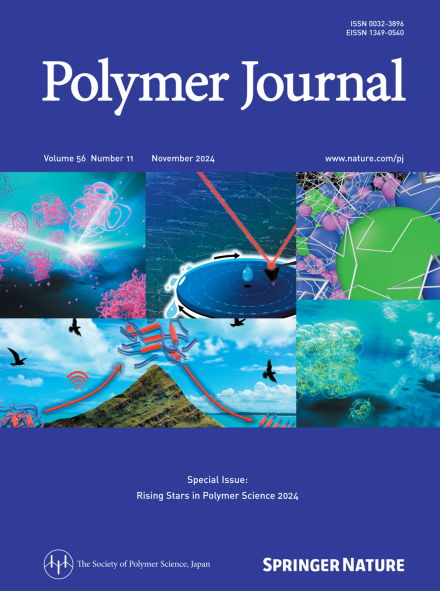苯乙烯/丙烯腈接枝共聚改性和纤维素纳米纤维增强脱蛋白天然橡胶的表征
IF 2.7
4区 化学
Q3 POLYMER SCIENCE
引用次数: 0
摘要
天然橡胶(NR)和纤维素是发展可持续材料的有前途的生物聚合物。天然橡胶具有若干优越的性能,如优异的性能和弹性。此外,纤维素纳米纤维(CNFs)的最大优点是具有较高的机械强度,非常适合在其他聚合物上制作增强结构域。然而,NR和CNFs之间的极性差异会显著影响复合材料的性能。本研究研究了苯乙烯/丙烯腈在脱蛋白天然橡胶(DPNR)上的接枝共聚,以提高其极性、热稳定性和机械性能。利用超声波将天然橡胶经CNF分散体在乳胶中接枝CNF制备复合材料,以改善NR的力学性能。通过拉伸试验研究了材料的力学性能,在CNF为1.0 wt时,接枝共聚物基体域复合材料的拉伸强度。%(5.09±0.49 MPa)是含DPNR的复合材料(1.6±0.14 MPa)的3倍。利用扫描电镜分析了CNFs在不同橡胶基体结构域内的分散能力。通过热重分析验证了所得产品热性能的提高。天然橡胶(NR)和纤维素纳米纤维(CNF)是发展可持续材料的有前途的生物聚合物。NR具有优异的弹性和回弹性,而CNF提供高机械强度的增强。由于极性差异,NR与CNF的相容性受到限制。为了解决这个问题,将苯乙烯/丙烯腈接枝共聚到脱蛋白天然橡胶(DPNR)上,从而改善了极性、热稳定性和机械强度。CNF被超声分散在乳胶中以制造增强复合材料。由此产生的材料表现出优异的性能,使其适合于先进的可持续应用。本文章由计算机程序翻译,如有差异,请以英文原文为准。

Characterization of deproteinized natural rubber modified via graft copolymerization with styrene/acrylonitrile and reinforced with cellulose nanofibers
Natural rubber (NR) and cellulose are promising biopolymers for the development of sustainable materials. Natural rubber has several superior properties, such as outstanding properties and resilience. Moreover, the greatest advantage of cellulose nanofibers (CNFs) is their high mechanical strength, which is very suitable for making reinforcement domains on other polymers. However, the disparity in polarity between NR and CNFs significantly influences the properties of the resulting composite materials. This study investigated the graft copolymerization of styrene/acrylonitrile onto deproteinized natural rubber (DPNR) to increase its polarity, thermal stability, and mechanical properties. The composite materials were prepared from natural rubber grafted with CNFs via CNF dispersion in latex using ultrasonic waves with the aim of improving the mechanical properties of NR. The mechanical properties of the materials were studied via tensile testing, where the tensile strength of the composite with the graft copolymer matrix domain at a CNF of 1.0 wt.% (5.09 ± 0.49 MPa) was three times greater than that of the composite with DPNR (1.6 ± 0.14 MPa). The dispersion capacity of CNFs within various rubber matrix domains was assessed by analyzing morphological alterations with scanning electron microscopy. The increase in the thermal properties of the resulting products was verified via thermogravimetric analysis. Natural rubber (NR) and cellulose nanofibers (CNF) are promising biopolymers for developing sustainable materials. NR offers excellent elasticity and resilience, while CNF provides high mechanical strength for reinforcement. Due to polarity differences, NR’s compatibility with CNF is limited. To address this, graft copolymerization of styrene/acrylonitrile onto deproteinized natural rubber (DPNR) was performed, improving polarity, thermal stability, and mechanical strength. CNF were ultrasonically dispersed in latex to create reinforced composites. The resulting materials exhibit superior properties, making them suitable for advanced sustainable applications.
求助全文
通过发布文献求助,成功后即可免费获取论文全文。
去求助
来源期刊

Polymer Journal
化学-高分子科学
CiteScore
5.60
自引率
7.10%
发文量
131
审稿时长
2.5 months
期刊介绍:
Polymer Journal promotes research from all aspects of polymer science from anywhere in the world and aims to provide an integrated platform for scientific communication that assists the advancement of polymer science and related fields. The journal publishes Original Articles, Notes, Short Communications and Reviews.
Subject areas and topics of particular interest within the journal''s scope include, but are not limited to, those listed below:
Polymer synthesis and reactions
Polymer structures
Physical properties of polymers
Polymer surface and interfaces
Functional polymers
Supramolecular polymers
Self-assembled materials
Biopolymers and bio-related polymer materials
Polymer engineering.
 求助内容:
求助内容: 应助结果提醒方式:
应助结果提醒方式:


